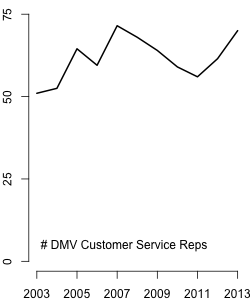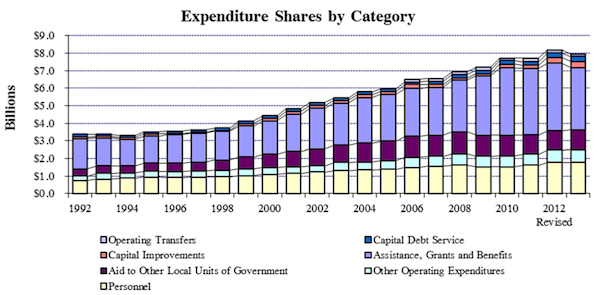
One of the most interesting battles going on in the state house this year is over the fate of the “payday lending” industry. Payday loans are short-term loans, typically arranged something like this: I loan you $100 now in return for $110 taken from your next paycheck in a couple of weeks.
This sounds good, unless you do the math and notice that this works out to about a 260% annual interest rate. If you don’t, it’s likely enough that in two weeks you’ll ask for an extension, and it only takes a couple of dozen like you and suddenly my business is booming. And there are a lot more customers than that around here.
It wasn’t legal to charge interest rates that high until an exception to usury laws was carved out for check-cashing businesses in 2001. According to Margaux Morisseau, who is spearheading the effort to repeal this exception, payday lenders in Rhode Island now write over 140,000 of these loans each year, totaling $50 million, the bulk of which are written by Advance America, based in South Carolina, and Check ‘n Go, nominally based in Ohio, though it might be controlled by partners based in Texas or London. You can admire the process at rhodeislandpaydayloans.com. My favorite quote:
“When it is due date of your RI payday loan, the loan amount and the service charge will be automatically debited against your pay check. An extension of your RI cash advance is also possible by paying an extension fee.”
There are a couple of interesting points to the story (beside the lack of proofreaders for web content). First, it is consistently astonishing to me both how profitable it can be to exploit poor people — and how many financiers are eager to do so. After all, a huge amount of the financial carnage of the 2008 meltdown was built on liar loans and various kinds of mortgage fraud aimed at sucking wealth from low-income families who hoped to afford a home. (And no, the Community Reinvestment Act had nothing to do with this, as you’ll doubtless read in uninformed comments.)
Obviously there is a risk associated with these kinds of loans, but even assuming a generous loan loss provision, we’re talking about more than doubling one’s investment each year. These are returns investors in more, um, traditional businesses can only dream of.
There’s a bill in the Assembly that would repeal this exception and limit interest to 36% — still awfully high, but in the range that banks charge on some credit cards. Morisseau has put together an impressive coalition to push it, and Representative Frank Ferri and Senator Juan Pichardo have been very energetic sponsors. Morisseau and Ferri found 50 co-sponsors out of 75 members for the House Version, and she and Pichardo got 25 out of 50 in the Senate. Sounds like a slam-dunk, right?
Wrong. On the other side, Advance America has retained Bill Murphy, the recently retired Speaker of the House.
So what can a retired Speaker do in the face of 50 house members who oppose him? Sure he knows where a lot of bodies are buried, but what can he possibly hold over so many people? How is this a fair fight?
Here’s how it works. Murphy’s services are not provided gratis to Advance America. They are paying him $50,000 this year, according to the Secretary of State’s web site. How much work will that entail? A bunch of phone calls and a handful of meetings. Nice work if you can get it.
And you can get it if you try — so long as you’re a current member of the House or Senate leadership. If Bill Murphy can prove to Advance America that he’s worth $50,000 a year for almost no work, then Speaker Gordon Fox or Majority Leader Nick Mattiello or even Corporations Committee Chair Brian Patrick Kennedy can justifiably claim to be worth the same amount to lobbying clients who happen along after they retire from the House. In other words, killing a bill like this on Bill Murphy’s say-so is key to a big payday for them down the road. Preserving a system that benefits Murphy is the way to keep the trough full at which they might hope someday to feed.
Of course, there are lobbyists who do real work for their money — arranging testimony, doing research, preparing press campaigns — and some of those are even ex-legislators. But the real money is in having a name that can make things happen despite how many are on the other side.
Now in fairness, I have no idea whether Fox, Mattiello, or Kennedy hopes to cash in on their service in this way, and in all likelihood, neither do you. But a very compelling indicator of whether they do is if this bill — sponsored by two-thirds of the House — gets out of committee and onto the House floor for an actual vote. Are the people who control the agendae of the House and Senate interested in a democratically run General Assembly, or is their interest in preserving the system by which ex-legislators profit handsomely from what was, in theory, public service?
Appendix:
For comparison,
Dan Connors, former Senate Majority Leader
George Caruolo, former House Majority Leader
Stephen Alves, former Senate Finance Chair











